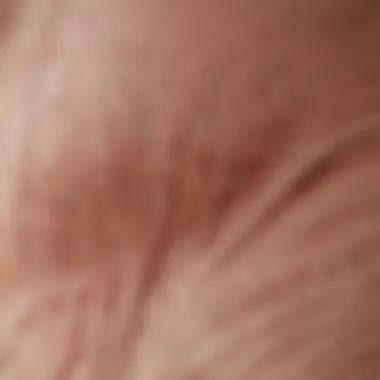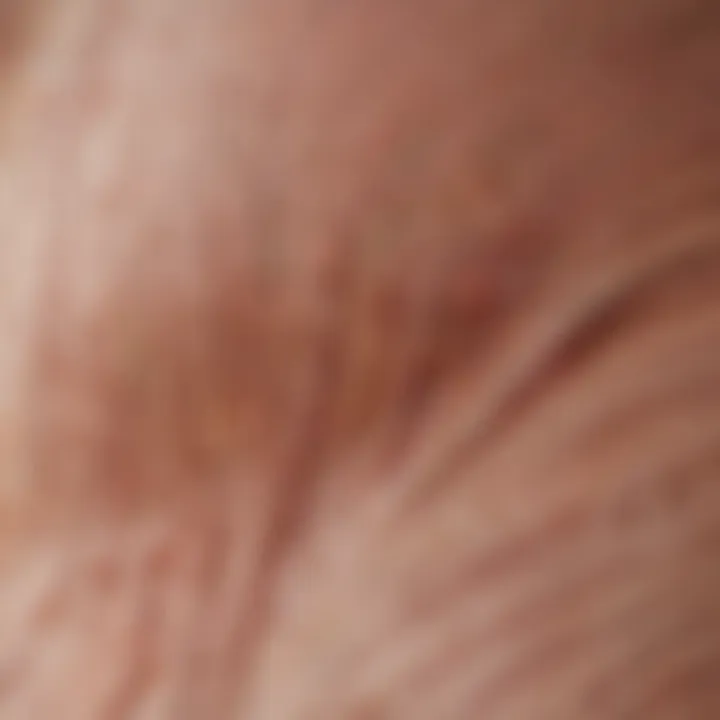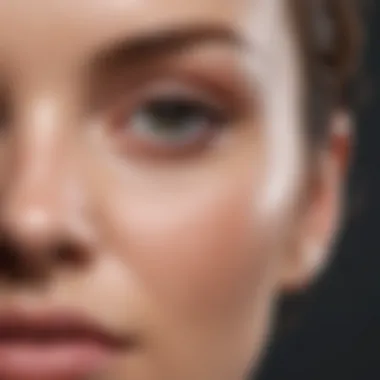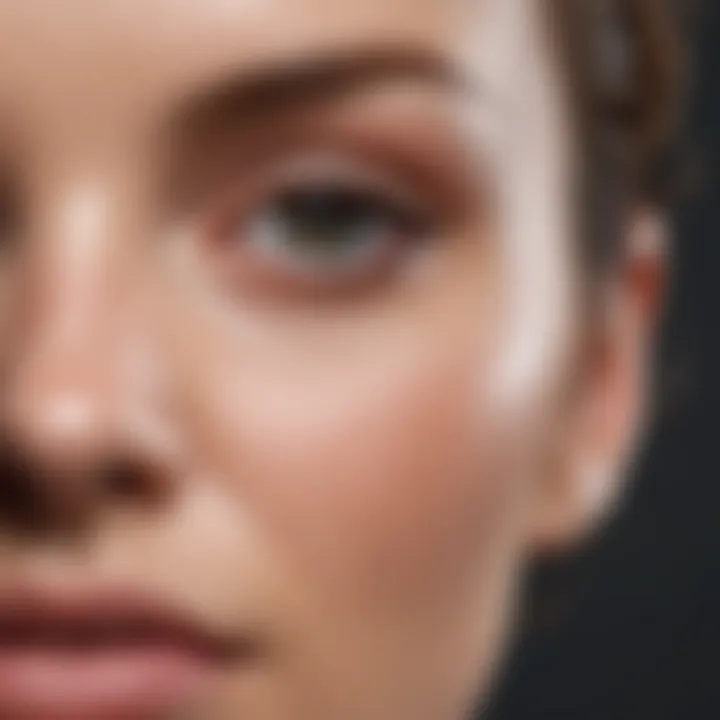Strategies to Prevent Ingrown Hairs After Waxing


Intro
Many beauty enthusiasts often find themselves grappling with the unfortunate aftermath of waxing: ingrown hairs. These pesky little nuisances not only ruin the satisfaction of smooth skin but can also lead to discomfort, irritation, and redness. Understanding the root causes of ingrown hairs and how to mitigate their occurrence is vital for anyone who regularly waxes.
This guide sets out to illuminate effective strategies for preventing ingrown hairs post-waxing. By exploring skincare routines, expert advice, and product recommendations, you will be well-equipped to embrace your waxing experience with confidence. Let's unpack the essentials for maintaining that coveted smooth skin, ensuring your beauty routine remains top-notch.
Beauty Tips and Tricks
Nurturing your skin before and after waxing can make a world of difference. Below are some practical tips to keep ingrown hairs at bay.
Skincare Routine Tips
- Exfoliation is Key: Keep your skin healthy by gently exfoliating a couple of days before your waxing appointment. Use a gentle scrub or a chemical exfoliant with ingredients like salicylic acid or glycolic acid. This helps remove dead skin cells and prevents hair from becoming trapped beneath the skin.
- Hydrate Your Skin: Proper hydration helps keep the skin supple. Use a lightweight moisturizer infused with ingredients such as aloe vera or hyaluronic acid.
- Limit Sun Exposure: After waxing, your skin is sensitive. Avoid direct sunlight or tanning beds, as they can irritate the skin and worsen any post-wax redness.
- Soothe with Natural Remedies: Aftercare matters. Applying tea tree oil, known for its antibacterial properties, can soothe inflammation and prevent infection.
Haircare Hacks
If you wax regularly, you’ll want to embrace techniques that allow for smoother regrowth. Here are some hacks:
- Keep Hair Length Consistent: Hair should generally be about a quarter-inch long for waxing to be effective. If your hair is too short, the wax won’t grip, and too long can lead to more snags.
- Shave in Between: If you notice your underarm area or legs are becoming too hairy before your next waxing session, shaving while allowing time for regrowth can stave off horrible ingrown hairs.
Makeup Application Techniques
While makeup won't prevent ingrown hairs, using it correctly on freshly waxed skin can minimize irritation:
- Use Mineral Makeup: Opt for mineral foundations, which are typically less irritating. They allow your skin to breathe and contain soothing ingredients.
- Avoid Heavy Products: Heavy, oil-based products can clog pores, potentially leading to more ingrown hairs. Stick to lightweight formulations.
"An ounce of prevention is worth a pound of cure! Adopt these tips to keep your skin smooth and beautiful after waxing."
Product Reviews
Finding the right products to complement your skincare routine post-waxing can be a game-changer. Here are some noteworthy mentions.
Skincare Product Reviews
- CeraVe Hydrating Cleanser: Nurturing and gentle, this cleanser helps remove impurities and hydrate the skin.
- Paula's Choice BHA Liquid Exfoliant: A trusted exfoliant that reduces redness and prevents clogged pores without irritation.
Makeup Product Reviews
- BareMinerals Original Foundation: A breathable powder that won’t aggravate sensitive skin.
- Clinique Moisture Surge: Lightweight and hydrating, perfect for just-waxed skin.
Haircare Product Reviews
- Nair Sensitivity Formula: For those opting for hair removal cremes, this is an excellent choice for sensitive skin.
By implementing these strategies and using quality products, you can significantly reduce the chances of experiencing ingrown hairs after waxing. This not only ensures comfort but also enhances the results of your waxing sessions.
Understanding Ingrown Hairs
Understanding ingrown hairs is crucial when considering the post-waxing care. These pesky hair issues can lead to discomfort, bumps, and even infections if not handled properly. Grasping the fundamentals of why and how ingrown hairs occur sets the stage for effective prevention strategies.
Definition and Characteristics
Ingrown hairs happen when a hair grows back into the skin instead of emerging from the follicle. This often results in red, inflamed bumps, sometimes filled with pus. They can appear anywhere that hair removal methods are used, including the legs, underarms, and bikini area. Some characteristics to keep in mind include:
- Appearance: They often look like small, raised bumps. Initially, they can be mistaken for acne or acne-like cysts.
- Location: Commonly found in areas that are frequently waxed or shaved.
- Sensation: If you've got one, you might feel itching or pain around the affected area.
The Biological Mechanism
To get a better grip on why ingrown hairs occur, let's dive into the biological mechanism. Each hair follicle is surrounded by a natural layer of skin. When hair is removed, especially through waxing, the follicle can be irritated. The hair may also curl back into the skin rather than pushing through it as it grows back.
Here’s how this typically unfolds:
- Growth Pattern: When hair grows back, it can take a turn prematurely or even grow sideways.
- Follicle Blockage: Dead skin cells, sweat, and oils can clog the follicle, making it hard for the hair to make its way out.
- Inflammation: As the body detects the ingrown hair, it responds with inflammation, which can lead to redness and discomfort.
This understanding of ingrown hairs helps guide effective prevention strategies post-wax, offering insights into how best to care for skin after hair removal.
By keeping these mechanics in mind, you can better appreciate the importance of post-waxing care routines designed specifically to minimize the risk of ingrown hairs.
Causes of Ingrown Hairs
Understanding the causes of ingrown hairs is crucial for anyone looking to maintain smooth skin after waxing. When hair follicles become trapped beneath the skin’s surface, it can lead to redness, discomfort, and sometimes infection. Knowing what triggers this issue can significantly help in selecting appropriate preventive measures. By tackling the underlying causes, individuals can reduce the likelihood of experiencing ingrown hairs, ultimately leading to a more enjoyable and confidence-boosting waxing experience.
Hair Type and Texture
One of the primary culprits behind ingrown hairs is the individual's hair type and texture. Curly and coarse hair tend to be more prone to curling back into the skin as it grows. When coarse hair is cut or waxed, it often has sharper edges, which can irritate the skin and increase the chances of it burrowing back into the follicle.
- Curly hair: This type can create a spiral growth pattern that causes it to bend back towards the skin.
- Fine hair: Though it might not be as prone to ingrown hairs as curly hair, fine hair can still get trapped in the follicle depending on the growth direction.
Therefore, understanding one's hair characteristics can play a significant role in pre-wax preparation and post-care routines. When people know their hair type, they can adopt more effective waxing and aftercare strategies.
Improper Waxing Techniques
Improper techniques during the waxing process can also set the stage for ingrown hairs. When the waxing strip is applied or removed incorrectly, it may not effectively remove the hair from the root. Hair that breaks off instead of being pulled out entirely is more likely to grow inward.
Some of the common mistakes include:
- Waxing against the hair growth direction: This can leave broken hairs that aren't effectively removed, increasing the chance of them growing back into the skin.
- Waxing over the same area multiple times: Repeatedly applying wax on one area can irritate the skin and create inflammation, causing hair to grow at odd angles.
These techniques highlight the importance of either investing the time to learn proper waxing methods or seeking help from professionals who can ensure a clean and effective waxing service.
Skin Conditions and Sensitivity
Certain skin conditions or heightened sensitivity can aggravate the likelihood of developing ingrown hairs. Conditions such as eczema or psoriasis can create uneven skin textures that make it difficult for hair to grow out properly. Additionally, sensitive skin can easily irritate post-waxing, leading to inflammation around hair follicles.
To minimize these risks, consider the following:


- Preemptive care: Use calming skin treatments before waxing to condition the skin.
- Patch tests: If trying a new product, it might be wise to test it on a small area to ensure it doesn't provoke an adverse reaction.
- Consulting with professionals: Engaging with dermatologists or skincare specialists can provide insights on personal skin concerns and tailor post-care routines accordingly.
In summary, being aware of these causes can empower beauty enthusiasts to take a proactive approach to prevention, creating smoother skin post-waxing and minimizing unnecessary discomfort.
Pre-Waxing Preparation
Preparing your skin before waxing is like laying down a solid foundation before building a house. It’s crucial for preventing those pesky ingrown hairs that can follow after hair removal. By taking a few careful steps ahead of time, you can significantly reduce your chances of dealing with irritation or bumps post-wax.
Exfoliation Techniques
Exfoliation is one of the most important aspects of pre-waxing prep. Think of it as spring cleaning for your skin. By sloughing off dead skin cells, you not only smooth the skin's surface but also help the hair to break through easily. This can stop hairs from curling back into the skin.
There are various methods to exfoliate:
- Physical Exfoliation: This involves using scrubs or loofahs. A scrub with fine granules works best; however, be gentle to avoid irritating your skin.
- Chemical Exfoliation: Products containing alpha hydroxy acids (AHAs) or beta hydroxy acids (BHAs) can deep clean the pores. You can use these a few days before your waxing appointment.
Aim to exfoliate your skin two to three days prior to waxing. Post-exfoliation, your skin should feel soft and smooth, setting the stage for a successful waxing session.
Skin Hydration Practices
Hydrated skin is happy skin. Giving your skin a good drink of moisture before waxing not only helps with the waxing process but also reaps benefits afterwards. Well-hydrated skin is less likely to become irritated or react poorly to waxing.
Key hydration tips include:
- Use a Lightweight Moisturizer: The days leading up to your wax, apply a gentle moisturizer daily. Look for ingredients like hyaluronic acid or glycerin to lock in moisture without clogging pores.
- Drink Plenty of Water: From the inside out, hydration can improve your skin's elasticity and appearance.
In the long run, keeping your skin's hydration levels balanced can also strengthen your skin’s barrier function, making it more resilient to post-waxing effects.
Consultation with a Professional
Before diving headfirst into waxing, chatting with a professional can work wonders. Sometimes it's just easy to forget that not all skin is created equal, and every individual has different needs when it comes to hair removal. A professional can provide insight tailored specifically to YOUR skin type and any previous experiences you’ve had.
Points to consider during your consultation:
- Discuss Hair and Skin Conditions: If you have sensitive skin or concerns like eczema or rosacea, be sure to tell your esthetician. They may recommend specific products or techniques to lessen any potential irritation.
- Ask About Products: A professional can guide you on the best products to prepare your skin. Maybe they'll tell you to avoid certain things or suggest others that work great for easing dehydration post-wax.
In summary, taking the extra time for pre-waxing preparation is a smart move that pays off in the end. Avoiding ingrown hairs after waxing is far easier with a little foresight, setting the stage for smoother skin.
Choosing the Right Waxing Method
When it comes to navigating the tricky waters of waxing, especially for those hoping to avoid the bane of ingrown hairs, picking the right method is like choosing the perfect bait for fish. Different approaches cater to varying skin types, pain tolerances, and even hair conditions, so understanding the distinctions can make all the difference. Selecting a waxing method that takes into account your unique needs serves as a crucial first step in ensuring smoother post-waxing outcomes.
Soft Wax Versus Hard Wax
Alright, let’s dive into the big split between soft wax and hard wax. Soft wax, commonly seen in salons, is essentially a thinner formula that adheres to both skin and hair. While it can give a clean finish, if not applied correctly, it might cling too diligently, leading to skin irritation.
On the flip side, hard wax, which is generally thicker, only sticks to the hair. When it cools, it solidifies and can be removed without the need for fabric strips. This often results in a gentler experience for skin, especially sensitive skin. Those with curly and coarse hair might find hard wax a better bet, as it grabs the hair more effectively without pulling the skin into the equation.
In short, the choice boils down to personal preference and specific needs:
- Soft Wax
- Hard Wax
- Pros: Faster application, better for large body areas.
- Cons: More painful for sensitive skin.
- Pros: Less irritation, great for sensitive areas like underarms or bikini line.
- Cons: Slower to apply, might be less effective for finer hair.
Benefits of Sugaring
Sugaring is often the underdog in the waxing world, yet it packs a punch with its natural approach. This method uses a mixture of sugar, water, and lemon juice to create a paste that’s applied at body temperature. Because it doesn’t adhere strongly to skin, sugaring minimizes irritation, making it a golden choice for those who typically wrestle with sensitive skin or rehabbing existing ingrown hairs.
Another feather in its cap is how sugaring pulls the hair out in the direction of growth. This reduces the chance of hair breaking and, consequently, reduces the risk of those annoying ingrown hairs that can lead to a world of discomfort. Plus, some folks tout that sugaring is less painful than traditional waxing, an added bonus for beauty enthusiasts wary of the pain that can accompany hair removal.
The benefits extend beyond immediate results. Regular sugaring can lead to finer, sparser hair regrowth over time, which might mean less discomfort during your next treatment.
In summation, whether you opt for the speed of soft wax, the gentleness of hard wax, or the natural approach of sugaring, knowing the pros and cons is vital. Arm yourself with information, choose wisely, and help pave the way to virtually ingrown-hair-free skin.
Post-Waxing Care
Post-waxing care is vital for maintaining the integrity of your skin and minimizing the risk of ingrown hairs. After the waxing session, your skin is often sensitive and can be quite reactive. Addressing these post-waxing needs is as crucial as the preparation before the treatment. A well-thought-out care plan can make a world of difference.
Cleansing the Skin
Clearing away any residual wax and debris from the skin is the first step you should take after waxing. This helps to prevent irritation and possible infection. Use a gentle cleanser, preferably one without harsh chemicals or fragrances, as these can exacerbate sensitivity.
- Apply lukewarm water to soften the skin.
- Use your fingers or a soft cloth to massage the cleanser gently.
- Rinse thoroughly to ensure that no product remains, as leftover residues can clog pores.
Keeping the skin clean is important for allowing it to breathe and heal.
Moisturizing and Soothing Treatments
Once the skin is clean, it’s essential to provide it with some much-needed hydration. Moisturizing soothes irritation, making it less likely for hairs to become trapped beneath the skin. A product that contains natural ingredients like aloe vera or chamomile can be particularly effective in calming down any redness or inflammation.
- Apply a hydrating lotion or cream once the skin is dry.
- Look for active ingredients like salicylic acid or glycolic acid, which can help prevent clogging of the hair follicles.
- A lightweight, non-comedogenic moisturizer will allow your skin to retain moisture without adding unnecessary oils.
Following this step can not only help your skin feel better but also reduces the chances of bumps and irritation that lead to ingrown hairs.
Avoiding Irritation from Clothing
What you wear after waxing can impact your skin's recovery. Tight clothing can lead to friction against your freshly waxed skin, resulting in discomfort and potentially aggravating any irritation.
- Opt for loose-fitting garments to allow your skin to breathe.
- Natural fabrics such as cotton can help minimize irritation, as they don't trap heat and moisture as synthetic fabrics tend to.
- If you must wear something tighter, consider garments that provide a lining or a buffer between your skin and the fabric.
Remember: An ounce of prevention is worth a pound of cure! Keeping your skin free from irritation goes a long way in ensuring a smooth, beautiful complexion.
Selecting the right clothing can be simple yet effective.
By giving the necessary attention to post-waxing care, you significantly decrease the risk of dealing with pesky ingrown hairs later on. Paying heed to cleansing, moisturizing, and selecting appropriate clothing are the cornerstones of maintaining healthy skin post-wax.


Long-Term Prevention Strategies
Long-term prevention of ingrown hairs after waxing is a crucial aspect of maintaining healthy skin. It goes beyond immediate care; it’s about establishing routines and practices that mitigate irritation and prevent hairs from curling back into the skin. To achieve this, awareness of skin needs and proactive measures are vital. The benefits are clear: smoother skin, reduced discomfort, and enhanced confidence.
Regular Exfoliation Post-Wax
Regular exfoliation is like giving your skin a breath of fresh air after waxing. It's essential to remove dead skin cells that may trap hairs under the surface. Consider using gentle scrubs or exfoliating gloves two to three times a week, but be mindful of not overdoing it especially if your skin is still sensitive post-wax.
- Physical Exfoliation: This involves using scrubs or tools to manually shed dead skin. Opt for products with natural ingredients like brown sugar or coffee grounds. They can provide a soothing yet effective scrub that’s not too harsh.
- Chemical Exfoliation: Products containing alpha-hydroxy acids (AHAs) or beta-hydroxy acids (BHAs) can deeply penetrate and break down dead skin cells, making them ideal for those prone to ingrown hairs.
Incorporating this practice into your routine can help create a smoother canvas, allowing hairs to grow outward instead of becoming trapped.
Using Ingrown Hair Serums
Investing in quality ingrown hair serums can be a game changer. These serums are specifically formulated to reduce inflammation and encourage hair to break through the skin. When selecting a product:
- Look for serums with ingredients like salicylic acid or tea tree oil. They possess anti-inflammatory properties and can soothe irritated skin effectively.
- Applying these serums immediately after waxing and consistently thereafter can significantly decrease the likelihood of ingrown hairs. Incorporating this into an after-care regime makes a real difference over time.
Incorporating a Consistent Routine
Setting up a consistent skincare routine that addresses both waxing aftermath and skin health is crucial. This doesn’t need to be a complicated affair, but a few focused steps daily can lace your efforts in preventing ingrown hairs.
- Daily Cleansing: Cleanse your skin daily to remove impurities without stripping it of moisture. Choose a mild cleanser, especially for sensitive areas.
- Moisturizing: Keeping your skin hydrated can help keep it elastic and reduce irritation. Choose a non-comedogenic moisturizer that won't clog pores or cause unwanted breakouts.
- Tailored After-Care: After each wax, find a soothing lotion or balm that can help calm the skin down. Products with aloe vera or chamomile work wonders for reducing redness and irritation.
In summary, engaging in these long-term strategies can steer you clear of the uncomfortable side effects of waxing. It’s about marrying diligence with care, ensuring your skin health is not a fleeting thought but an ongoing commitment. As they say, prevention is better than cure. By weaving these practices into daily life, you set the stage for a smoother, carefree experience.
Home Remedies for Ingrown Hairs
When dealing with ingrown hairs, many turn to effective home remedies before seeking professional treatments. These remedies offer a cost-effective and accessible way to deal with the discomfort associated with ingrown hairs. They can help alleviate irritation and promote healthy skin recovery after waxing.
Natural Exfoliants
Exfoliation plays a crucial role in preventing and treating ingrown hairs. Using natural exfoliants can gently remove dead skin cells that may block hair follicles. Examples of natural exfoliants include:
- Sugar Scrubs: Mixing sugar with a bit of olive oil creates a paste that can be rubbed gently on the skin. This not only sloughs off dead skin but also hydrates it, leaving the skin soft.
- Coffee Grounds: After brewing your morning cup, save the grounds for a post-wax scrub. The coarse texture helps in exfoliating the skin effectively, reducing the chances of hairs getting trapped underneath.
- Baking Soda Paste: Mix baking soda with water to form a paste that can help to clarify the skin’s surface. Apply it gently and rinse with warm water.
- Oatmeal: This is a very soothing option, especially for sensitive skin. Ground oatmeal mixed with water can be applied as a soft scrub, providing both exfoliation and relief from irritation.
Using these natural options can help keep skin clear and smooth, preventing those pesky ingrown hairs from rearing their ugly heads.
Applying Warm Compresses
Warm compresses can be a game-changer when it comes to dealing with ingrown hairs. They work by softening the skin around the ingrown hair, allowing it to break through the surface more easily.
Here’s how to do it:
- Prepare a clean washcloth: Soak the washcloth in warm water that is not too hot to avoid burns.
- Apply to the area: Place the warm cloth over the skin where you suspect an ingrown hair. Hold it there for about 10 to 15 minutes. The warmth will help to relax the skin and loosen any trapped hair.
- Gently massage the area: After removing the cloth, you can lightly massage the affected area to encourage the hair to emerge.
- Repeat as necessary: This can be done a couple of times a day until the hair grows out.
This simple method is not only effective but also quite soothing for irritated skin.
By integrating these home remedies, you can manage ingrown hairs more effectively and significantly reduce discomfort. The use of inexpensive, accessible ingredients enhances your ability to maintain skin health and ensures smoother skin post-waxing.
Professional Treatments
When it comes to tackling the stubborn issue of ingrown hairs after waxing, professional treatments can be a game-changer. These options offer a level of precision and expertise that's often hard to achieve at home. Not only can they address the immediate concerns of ingrown hairs, but they also contribute to the overall health of your skin, preventing future occurrences.
Dermatological Procedures
One of the most effective ways to manage ingrown hairs professionally is through dermatological procedures. Treatments like chemical peels and microneedling are designed to promote skin renewal and enhance texture.
- Chemical Peels: These involve applying a solution to the skin that exfoliates dead skin cells, effectively unclogging pores and helping to release trapped hairs.
- Microneedling: This technique uses tiny needles to create micro-injuries in the skin, stimulating collagen production. The improved skin texture can help prevent hairs from curling back into the skin.
Both methods have their own sets of benefits. Chemical peels can be relatively quick, requiring minimal downtime, while microneedling can yield longer-lasting results. However, they aren't one-size-fits-all, and it’s essential to consult with a dermatologist to determine which procedure suits your skin type and concerns best.
Laser Hair Removal as a Solution
For those who face recurring problems with ingrown hairs, considering laser hair removal might be the way to go. This method goes beyond merely removing hair; it targets hair follicles and diminishes their ability to grow back.
- How It Works: Laser hair removal uses concentrated light to penetrate the skin, targeting the melanin in the hair. This damage to the follicle reduces the likelihood of hair growth, and consequently, the risk of ingrown hairs.
- Benefits: Unlike waxing, which removes hair from the root and may lead to new hairs growing in a troublesome manner, laser hair removal minimizes the regrowth phase and helps in keeping the skin smooth and irritation-free.
However, it’s crucial to remember that results can vary between individuals based on skin type, hair color, and persistence. Multiple sessions are usually required to achieve the desired effect, but the results can be well worth it for those who struggle with ingrown hairs.
"Investing in professional treatments can save you time and discomfort in the long run. The expertise of a dermatologist can make a world of difference to your skin health."
Ultimately, tailoring the approach to your individual needs and sensitivity is critical. Consulting with a professional will provide guidance, ensuring you choose the best course of action and effectively mitigate the discomfort caused by ingrown hairs.
Lifestyle Adjustments
Making the right lifestyle adjustments can play a significant role in preventing ingrown hairs after waxing. These changes are often easy to implement but can have a powerful impact on your skin's health. By focusing on two main areas—diet and clothing choices—you can create a skin-friendly environment that encourages healthy hair growth and minimizes irritation.
Diet and Hydration
When it comes to skin health, what you put into your body is just as important as the products you apply externally. Diet and hydration deeply influence your skin's condition and resilience against ingrown hairs. Here are some considerations to take into account:
- Hydration: Keeping your skin hydrated is crucial. Drink plenty of water daily. It helps in maintaining skin elasticity and can prevent dryness, which, in turn, reduces the risk of hairs getting trapped under the skin.
- Vitamins: Nutrients like vitamins A, C, and E are vital for skin health. Incorporate colorful fruits and vegetables that are rich in these vitamins into your diet—think oranges, leafy greens, and berries. They help in cell regeneration and can promote smoother skin.
- Healthy Fats: Omega-3 fatty acids found in fish, flaxseeds, and walnuts create a natural barrier for your skin, protecting it from environmental stressors that may lead to irritation.
- Avoid Sugary and Processed Foods: Foods high in sugar and refined carbs can increase inflammation in the body, affecting your skin negatively. Trying to reduce your intake of pastries and fast food can lend a helping hand in keeping your skin smoother.
As a rule of thumb, remember that a fresher plate often translates into fresher skin.
Clothing Choices for Skin Health
The fabrics you wear can greatly affect how well your skin behaves, especially post-waxing.
- Breathability: Opt for loose-fitting clothing made from breathable fabrics such as cotton or linen. These materials allow for better air circulation, which can help reduce sweating and irritation resulting from the trapping of heat.
- Avoiding Friction: Tight clothing, while perhaps fashionable, can lead to friction on freshly waxed skin. Look for styles that are gentle against your skin, thereby reducing the chance of hair becoming ingrown.
- Color Choices: Light colors are better than dark ones for those sensitive to heat. Darker outfits can absorb more heat from the sun, potentially leading to sweating and irritation.
- Laundering Practices: Always wash new clothes before wearing them to minimize exposure to chemicals and dyes that might irritate the skin. Use a gentle, hypoallergenic detergent to avoid any unwanted rashes.
In summary, these lifestyle adjustments revolving around diet and clothing choices create a holistic approach to skin care post-waxing. Implementing these strategies will not only aid in preventing ingrown hairs but also enhance your overall skin health.
"Your skin is your body's largest organ—treat it with kindness and care, both inside and out."


Taking the time to make these conscious choices informs your skin's reaction and helps it to recover and thrive after waxing.
Skin Care Products to Avoid
In the quest to achieve smooth skin post-waxing, the selection of skin care products can play a pivotal role. Some items that may seem harmless can actually exacerbate the issue of ingrown hairs. When addressing strategies for preventing ingrown hairs, it’s essential to recognize which products belong in the "do not use" category. A careful examination of your skincare arsenal can mean the difference between a clean, irritation-free experience and a painful, uncomfortable aftermath.
Heavy Oils and Comedogenic Ingredients
Heavy oils and comedogenic ingredients can be a double-edged sword. While many oils can offer hydration and nourishment, certain ones can contribute to clogged pores. Ingredients like mineral oil, cocoa butter, or coconut oil are notorious for being comedogenic, meaning they can block hair follicles and lead to ingrown hairs. For those with sensitive skin or who are prone to breakouts, it’s best to be cautious about the oils you apply after waxing.
- Key oils to avoid:
- Mineral oil
- Coconut oil
- Cocoa butter
Instead, opt for lighter oils such as jojoba or argan oils; these are less likely to clog pores. Remember, if the oil feels thick on your skin, it’s probably best to give it a pass.
Harsh Scrubs and Chemicals
Post-waxing, the skin can be tender and sensitive. While exfoliation is crucial for preventing ingrown hairs, the method of exfoliation is just as essential. Harsh scrubs containing gritty particles, like crushed walnut shells or sugar, can damage fragile skin, leaving it open for irritation and inflammation. Likewise, chemical exfoliants with strong acids may throw your skin's natural balance out of whack.
Choosing a gentle chemical exfoliant can help maintain skin’s health without adding to the problem. Look for
gentler alternatives like:
- Lactic acid
- Salicylic acid
- Enzyme-based exfoliants from fruits like papaya or pineapple
In summary, being savvy about the ingredients you slather on your skin after waxing can greatly influence your experience.
“An ounce of prevention is worth a pound of cure.” It rings especially true when it comes to the delicate balance of skin post-waxing.
Prioritize skin-friendly formulas that nurture while steering clear of the heavy hitters that may do more harm than good. This thoughtful approach can make a world of difference, leading to smoother, healthier skin long after the waxing session has ended.
Understanding Your Skin
Understanding your skin is crucial, especially when it comes to preventing ingrown hairs after waxing. Each person’s skin reacts differently to various cosmetics and hair removal techniques. Recognizing these unique characteristics allows individuals to adopt effective strategies tailored to their specific needs.
Knowing your skin type can help in selecting the right products that won’t aggravate sensitivity, allowing for smoother skin post-waxing. Beyond just avoiding discomfort, this knowledge can lead to better overall skin health, minimizing possible reactions during the waxing process. Listening to your skin is key; it speaks volumes about what it craves or what it should avoid.
Identifying Skin Types
Identifying your skin type isn’t just a matter of curiosity; it’s essential for effective skin care. Skin types can typically be divided into a few categories:
- Normal: Not too oily or dry; balanced moisture.
- Oily: Shiny appearance, enlarged pores, prone to acne.
- Dry: Rough, flaky, and may feel tight.
- Sensitive: Easily irritated, prone to redness or stinging.
- Combination: A mix of wet and dry areas, such as an oily T-zone with dry cheeks.
Understanding where you fit into these categories will help you select products and techniques that align with your skin's natural tendencies. For instance, oily skin might need lighter formulas post-wax, while dry skin may benefit from more nourishing creams.
Skin Sensitivity Considerations
Sensitivity can vary widely and needs special consideration especially after waxing. Certain skin types—particularly sensitive skin—are more prone to irritations like redness, swelling, and burning sensations following hair removal.
- Patch Testing: Before introducing new products, especially post-wax soothing agents, conduct a patch test. Apply a small amount on an inconspicuous area to see how your skin reacts.
- Ingredients Matter: Look out for potential irritants. Products with alcohol, artificial fragrances, or harsh chemicals can causemore harm than good, particularly after waxing.
- Environmental Factors: Weather and pollution can exacerbate skin sensitivity. Keep this in mind; during harsh weather, more care may be needed in post-wax routines.
Remember, a well-informed approach—choosing the right products and techniques aligned with your skin type—can contribute significantly to preventing ingrown hairs and maintaining overall skin health.
Common Myths About Ingrown Hairs
Ingrown hairs can be a pesky problem, especially after waxing. Understanding the common myths surrounding them is crucial for maintaining healthy skin and preventing discomfort. Misinformation can lead to poor skincare practices, which only worsen the issue. In this section, we will clarify these misconceptions so that beauty enthusiasts can make informed decisions about their post-waxing care.
Exposing Misconceptions
Many myths circulate regarding ingrown hairs and their causes. Let's tackle these head-on to reveal the truth behind them.
- Myth: Ingrown Hairs Only Happen After Shaving
Reality: While shaving does contribute to ingrown hairs, waxing or any hair removal method can also lead to them. Waxing can sometimes cause hair to be removed at an angle, increasing the likelihood of hairs curling back into the skin. - Myth: Exfoliation Makes Ingrown Hairs Worse
Reality: Actually, regular exfoliation can help reduce the occurrence of ingrown hairs. By sloughing off dead skin cells, exfoliation frees the path for hairs to grow outward rather than curling back into the follicle. It's essential to use gentle techniques, particularly right after waxing. - Myth: All Skin Types Are Prone to Ingrown Hairs
Reality: While anyone can develop ingrown hairs, certain skin types, particularly curly or coarse hair types, are more susceptible. Adjusting the hair removal and aftercare methods according to individual skin characteristics can strengthen prevention. - Myth: You Should Pull Out Ingrown Hairs
Reality: The impulse to pluck an ingrown hair can be strong, but resist it. Pulling can lead to infections or scarring. Instead, using warm compresses can help bring the hair closer to the surface, allowing it to emerge naturally. - Myth: Body Hair Removal Should Be Done as Infrequently as Possible
Reality: Consistency is key. Regular hair removal can keep hair follicles accustomed to the process, which may help reduce the incidence of ingrown hairs over time.
"Understanding the facts about ingrown hairs is as vital as knowing how to care for your skin post-waxing. Ignoring these myths can lead to unnecessary frustration and skin issues."
By shedding light on these often misunderstood points, beauty enthusiasts can better navigate their waxing experiences. Awareness of these myths is not just about avoiding discomfort, but it's also a step towards enhanced skincare practices that promote healthier skin overall. This clarity paves the way for more effective prevention strategies that can ultimately lead to smoother skin and a more enjoyable waxing journey.
Seeking Professional Advice
When it comes to preemptively tackling ingrown hairs, seeking professional advice can be a game changer. Beauty enthusiasts often dive into home remedies or popular products without fully understanding their skin type or the unique needs of their hair follicles. Consulting with a trained dermatologist can provide a custom approach to skincare that’s tailored specifically to your circumstances. This ensures you are not just treating the symptoms but addressing the root causes.
Why It's Important
Professional consultations can unveil insights about your skin and hair that you might never have considered. For example, did you know that the texture of your hair can significantly influence whether you’re prone to ingrown hairs? Specialists can conduct thorough assessments and recommend tailored solutions rather than generalized advice.
Additionally, dermatologists are aware of the latest advancements in skincare products and treatments, which can play a key role in preventing ingrown hairs. Their expertise can guide you away from ineffective products and lead you to those that could truly help.
Benefits of Professional Guidance
- Personalized Treatment Plans: Dermatologists can create individualized plans based on your skin type, lifestyle, and specific issues.
- Early Detection of Problems: They can spot potential skin conditions early on, which helps in preventing further complications.
- Technical Advice on Waxing: Professionals often have experience in different waxing techniques and can recommend methods that will be less likely to irritate your skin.
- Access to Advanced Treatments: Certain therapies, such as chemical peels or laser treatments, may be recommended that are unavailable or unsuitable for at-home care.
Considerations for Consulting a Dermatologist
Before jumping into a skincare regime, it’s wise to consider when to consult a dermatologist. Here are some scenarios that may warrant professional advice:
- If you frequently experience painful ingrown hairs, despite following a solid care routine.
- When over-the-counter products are failing, and you’re left feeling frustrated or confused.
- If you notice any unusual changes in the skin around your hair follicles, such as persistent redness or swelling.
Final Thoughts
In the realm of beauty and skincare, the battle against ingrown hairs is a common struggle for many individuals. The information shared throughout this article sheds light not just on the intricacies of ingrown hairs, but it also brings to the forefront the various effective strategies to avoid them post-waxing. Understanding the scientific underpinnings of how hair growth and skin function can significantly reduce discomfort and frustration associated with this issue.
This guide serves as a roadmap for beauty enthusiasts aiming for that coveted smooth skin. Each strategy presented, from careful pre-waxing rituals to post-care treatments, highlights key methods that directly mitigate the chances of hair becoming trapped beneath the skin. Furthermore, the exploration of lifestyle adjustments, proper product use, and effective home remedies empowers individuals to take proactive measures in their skincare routine.
Ultimately, the importance of these considerations cannot be overstated. Ingrown hairs can not only lead to physical discomfort but can also affect one’s confidence and self-esteem. By applying the insights and recommendations in this guide, readers can look forward to a more pleasant waxing experience and a healthier skin profile.
Moreover, imparting knowledge helps demystify common myths, enabling individuals to navigate the beauty landscape with informed decisions. Engaging in the ever-evolving conversation around skincare and hair removal can lead to a better understanding of one’s unique needs and preferences.
Remember, investing time in preparation and aftercare is just as essential as the waxing process itself. Your skin deserves the same level of care as the styling techniques you employ.
Summarizing Key Takeaways
- Personalized Care: Understanding skin type and individual hair characteristics can tailor your approach to prevent ingrown hairs.
- Pre-Wax Rituals: Exfoliation and hydration are foundational steps in preparing your skin for waxing. Ensure to follow these diligently.
- Post-Care Importance: Immediately after waxing, practicing proper skincare routines—like moisturizing and avoiding tight clothing—can significantly reduce irritation.
- Regular Maintenance: Commit to consistent exfoliation and incorporate specialized products designed to combat ingrown hairs.
- Professional Guidance: When in doubt, seeking advice from skincare professionals can provide tailored solutions and treatments suited to your personal needs.
By adopting these strategies and prioritizing skin health, you can minimize the risk of ingrown hairs and enhance your overall skincare routine. This not only leads to successful waxing and hair removal experiences but also sets the stage for long-term beauty and confidence.







